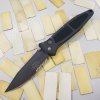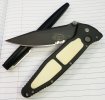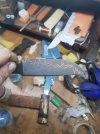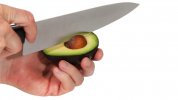-
The BladeForums.com 2024 Traditional Knife is available! Price is $250 ea (shipped within CONUS).
Order here: https://www.bladeforums.com/help/2024-traditional/
You are using an out of date browser. It may not display this or other websites correctly.
You should upgrade or use an alternative browser.
You should upgrade or use an alternative browser.
What's going on in your shop? Show us whats going on, and talk a bit about your work!
- Thread starter WillSwift
- Start date
- Joined
- Mar 23, 2021
- Messages
- 14
Elmax yakutian knife
- Joined
- Mar 10, 2013
- Messages
- 1,074
That's awesome!Elmax, copper, nickel, 440cView attachment 1659040
- Joined
- Mar 23, 2021
- Messages
- 14
Thnx, it was difficult, but interesting) Now I can weld copper and powder steel! It's been a long way...That's awesome!
- Joined
- Jun 29, 2014
- Messages
- 439
Made this super thin chef knife a couple years ago and had it come back in to the shop for a massive chip! He admitted that he was being far from careful with an avocado pit, and was very apologetic about the whole thing, but I think the repair turned out pretty well considering. It will be a bit thicker behind the edge now, which evidently might be a good thing...




- Joined
- Oct 10, 2018
- Messages
- 463
It's never a bad thing to get real world data on your knives' durability.Made this super thin chef knife a couple years ago and had it come back in to the shop for a massive chip! He admitted that he was being far from careful with an avocado pit, and was very apologetic about the whole thing, but I think the repair turned out pretty well considering. It will be a bit thicker behind the edge now, which evidently might be a good thing...
It should be added that a little education can go a long way. Chef knives cut far better when they're super thin but a thin, hard knife should never be whacked into an avocado pit to remove it or pushed through chicken bones or used on frozen food.
- Joined
- Jun 3, 2019
- Messages
- 2,714
Avocado pits are not really all that hard.... however, i wonder if that chip came from bending the blade sideways once it was embedded in the avocado pit? Either way, better to use a thicker blade for that action....Made this super thin chef knife a couple years ago and had it come back in to the shop for a massive chip! He admitted that he was being far from careful with an avocado pit, and was very apologetic about the whole thing, but I think the repair turned out pretty well considering. It will be a bit thicker behind the edge now, which evidently might be a good thing...


- Joined
- Oct 10, 2018
- Messages
- 463
If there's photo proof, it isn't a jokethis way?? No, please no, tell me it's a joke!
- Joined
- Jun 3, 2019
- Messages
- 2,714
I do that all the time. (we eat a LOT of avocados). BUT - dont "slap" .... carefully work the blade into the pit (the "slap" method is an invitation to a cut hand). Then, yes, twist to loosen the pit. With a reasonably ripe avocado the pit just releases. For a non ripe fruit, this does NOT work. However, I always use a pretty robust blade to do this (I have not yet found a better way to deal with an avocado.....)
Last edited:
- Joined
- Jun 29, 2014
- Messages
- 439
Yeah that's certainly what happened. I do it too, but with a much thicker/softer kitchen utility knife...
- Joined
- Jun 29, 2014
- Messages
- 439
Yes I agree, and I always include a care and use sheet with every knife, but customers are gonna do whatever they feel like at the end of the day. In this case, he knew it was his fault and didn't try to blame the knife itself, so I'm not upset about it.It should be added that a little education can go a long way. Chef knives cut far better when they're super thin but a thin, hard knife should never be whacked into an avocado pit to remove it or pushed through chicken bones or used on frozen food.
Sean Yaw
Gold Member
- Joined
- Feb 26, 2019
- Messages
- 418
I finished up #12 recently. It turned out well (don't mind the rain drops in the pics). I am getting the hang of hand sanding blades. The action is good too. I find it harder to dial that in on big slipjoints. If I weaken the spring too much to make the action gentle, then I get blade rap on the spring. I got it to a sweet spot on this one.
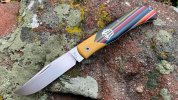



- Joined
- Jun 29, 2014
- Messages
- 439
In other news, I added a sweet pull-out water bucket to my belt grinder station!







